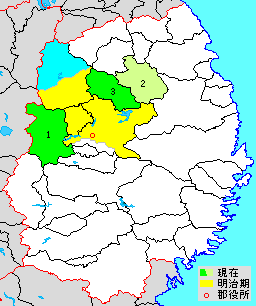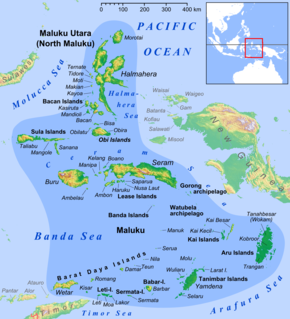Ro Lala, Lady Mara, maiden name Litia Cakobau Lalabalavu Katoafutoga Tuisawau was a Fijian chief, who was better known as the widow of Ratu Sir Kamisese Mara, modern Fiji's founding father who served for many years as Prime Minister and President of his country. As Fiji's First Lady, Adi Lala took on a diplomatic role, frequently representing her country abroad. She was regarded as a formidable and astute woman, whose influence on her husband was said to be considerable.

Aikō District is a district located in central Kanagawa Prefecture, Japan. It currently consists of only one town, Aikawa, and one village, Kiyokawa. The city of Atsugi was formerly part of Aikō District.

Iwate is a rural district located in Iwate Prefecture, Japan.

Shiwa is a rural district located in Iwate Prefecture, Japan.
The House of Chiefs in Fiji consists of the Fijian nobility, composed of about seventy chiefs of various ranks. It is not a formal political body and is not the same as the former Great Council of Chiefs, which was a political body with a prescribed constitutional role, although the membership of the two bodies did overlap to a great extent.
The Mara are the native inhabitants of Mizoram in India, native to northeastern India, primarily in the Mara Autonomous District Council of the state of Mizoram, where they form the majority of the population. The Maras are related to Kuki and Mizos in India and Kachin, Karen, Shan and Chins in Myanmar. Significant numbers of Maras are also found living south-western and south-central part of Chin State (Burma), in Myanmar - the contiguous area of Mara area in India mostly separated by Kolodyne / Chhimtuipui / Beino river, which forms an international boundary. They were earlier known as the Lakher by outsiders as Tlaikao/Lushai called them by that name and as Zochhia by the Lai and Shendu by the Khumi people, Dai people, Shô people, Matu people, and Rakhaing, and the new name Mara was inserted in List of Scheduled Tribes in Mizoram state in 1978 replacing the old name. The Maras were in early period known to the outside world under different tribal names such as Mara, Lakher, Shendu, Magha, Miram, Baungshel or Shendoo, Maring, Zyu or Zao/Zho, Khuangsai, etc. They constitute a distinct tribal group lying in Siaha / Saiha district of Mizoram, while also occupying northern part of Paletwa township and Matupi township, Western and Southern part of Thlantlang township, Southern part of Haka township. They called themselves "Maras".
Bau is a small island in Fiji, off the east coast of the main island of Viti Levu. Bau rose to prominence in the mid-1800s and became Fiji's dominant power; until its cession to Britain, it has maintained its influence in politics and leadership right through to modern Fiji.
Namosi is one of Fiji's fourteen provinces and one of eight based in Viti Levu, the largest island. Located to the west of Suva, the province covers 570 square kilometers. Its population of 7,871 at the 2017 census was the second smallest of any Fijian province.
Serua is one of Fiji's fourteen Provinces. Its 830 square kilometers occupy the southernmost areas of Viti Levu, being one of 8 provinces based on Fiji's largest island. It had a population of 15,461 at the 2007 census.
Bulou is a title used by Fijian women of chiefly rank, in the Provinces of Nadroga-Navosa and Kadavu, and parts of Serua Province, in Fiji.
Montgomery District was an administrative district of the former Punjab Province of British India, in what is now Pakistan. Named after Sir Robert Montgomery, it lay in the Bari Doab, or the tract between the Sutlej and the Ravi rivers, extending also across the Ravi into the Rechna Doab, which lies between the Ravi and the Chenab. The administrative headquarters was the town of Montgomery, present-day Sahiwal. In 1978, the name of Montgomery District was changed to Sahiwal District.

Serua is a volcanic island located in the Banda Sea, Indonesia. Administratively it is part of the Maluku Tengah Regency, Maluku Province. The main village is Jerili.

Iino Domain was a feudal domain under the Tokugawa shogunate of Edo period Japan, located in Kazusa Province. The domain was centered on Iino Jin’ya, a fortified residence in what is now the city of Futtsu, Chiba. It was ruled for the entirety of its history by a branch of the Hoshina clan of Aizu.
Gagaja[ŋaŋatʃa] is a Rotuman word denoting the position of "Chief" or "Lord". This could be a formal chiefly position in one of the seven districts or a village chief as well as to anyone else, such as the Chairman of the Rotuma Island Council to whom respect and deference is owed based on their own skills and attributes. Unlike in many other Pacific cultures, the official chiefly positions are not allocated according to any strict primogeniture, but rather are elected from all eligible males within certain kạinaga to whom the chiefly title belongs.
Fijian tradition and ceremony is a living way of life that has remained intact for millennia, evolving as the Fijian nation has modernised over time, with various external influences from Pacific neighbours, and European and Asian society. The term Fijian in this article refers to "indigenous Fijians" or "I Taukei" as the term Fijian generally includes all citizens of Fiji. This article is a general overview of various aspects of Fijian tradition, social structure and ceremony, much of it from the Bauan Fijian tradition. There are variations from province to province. Many social intricacies depend on one's inherited social position and the occasion one is confronted with: each will have a particular social etiquette. The Fijian terms in this article are most often of the Bauan dialect.
Taukei ni Waluvu is a Fijian phrase for "Native of the Flood." It is the traditional chiefly title of the warrior hill clan Siko-Natabutale of Nairukuruku village. The history of the clan from the mid- nineteenth century, represent the social structures of the chiefly system, religion and western culture that supported colonialism in Fiji. Tradition, Christianity and British indirect rule were combined to legitimize what was accepted as the right way to govern. Condemned by some modern day critics as exploitative, the Fijian chiefly system was the medium of native social interdependence and a traditional contract shared by the indigenous clans of pre-colonial Fiji, that was utilized for colonial rule. Since Independence the chiefly system has had to adapt to the demands of modernity. Anthropologist Arthur Capell in his study of early tribal migration within Fiji made the point that, "the history of Fiji is the history of chiefly families." The phrase in fact emphasized the hierarchical nature of Fijian traditional society where chiefly power was held sacred. The relationship between Chiefs and Westerners in especially Missionaries thus became a focal point for gathering insight into Fijian culture and tradition in the nineteenth century. James Turner a latter anthropologist found, "The chiefly families of Nairukuruku were the first in the eastern highlands of Viti Levu to declare their allegiance to the central government and as a result of this support their influence expanded throughout the area".

Ali Pur Chattha is a town of Gujranwala District in the Punjab province of Pakistan. It is located at 32°16'0N 73°49'0E with an altitude of 193 metres (636 feet).
Nadroga, is a prominent dialect of the West Fijian languages spoken in mostly in the western region of the Fiji Islands. It is often used as the generic standard of West Fijian. It takes its name from the ancient region and modern day province of Nadroga/Navosa, in Viti Levu, an area already unique for its own material culture, language and beautiful landscapes. Known as one of the prestige dialects of Fiji, Nadroga is popularly identified, and sometimes lampooned, by the change of Standard Fijian 's' to 'h' and the turbulent pitch and rapidness in which the language is spoken and can widely be identified by non-speakers within Fiji as a result of those characteristics. It is a dialect that is less understood by native Fijian speakers due to different sounds and spelling of common words.(Becker E. Anne, 1995) For example, the Fijian greeting word "bula" is "cola" in Nadroga/Navosa dialect.

The Chilean Iron Belt is a geological province rich in iron ore deposits in northern Chile. It extends as a north-south beld along the western part of the Chilean regions of Coquimbo and Atacama, chiefly between the cities of La Serena and Taltal. The belt follows much of the Atacama Fault System and is about 600 km long and 25 km broad.






